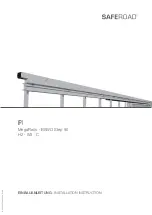
085501847c
11516-35c
3
3. Taking into operation
After the removal of the lateral safety screws, the casing can be opened by removing the hood. The connection clamp is ther e-
fore freely accessible. The following safety references are to be given consideration before opening the casing.
The electrical connection must only be carried out by such persons as are authorised to do so! It must be ensured
before opening the casing that the light is not under voltage and has been voltage-free for at least 10 minutes!
Attention, false operating voltages may lead to malfunctions or the destruction of the device!
The casing must be closed after the completion of the work and before switching on the all-round
flashlight.
The device is provided with a reverse polarity protection. No function when polarity is reversed!
The operating voltage connection for the flashlight and monitoring unit as well as the connection for the alarm connector
is made after opening the housing by the forward accessible and labelled clamp. Ensure that the apparatus is only oper-
ating with the prescribed voltage.
Operating voltage
Flash monitoring
Operating voltage
flashlight
(normal operating S1 open,
alarm relay with
S2 closed -> no fault)
purpose driven contact
and connection break monitoring
with short circuit monitoring
extenal fault monitoring
operating voltage
flashlight
24 V DC
1
2
control
flash light
flash tube
S1
operating voltage
flash monitoring
24 V DC
3
4
7
5
6
8
S2
optical receiver
fault signalling
monitoring switch/
Fig. 1
Fig. 2
Safety related application conditions
To achieve a high level of safety a superior system must be available, which is in a position to implement a fault analysis on
the basis of the alarm connector S1 and S2 in connection with the operating state of the lights. The following connections
between the operating state and alarm connection are thus possible:
1. Turning on the supply voltage of the flashlight (signal giving) and the flash monitoring results, in a fault free state, in a n
exchange of the relay contacts S1 and S2. If the exchange does not take place then there is a fault as regards the flas h-
light, the optical monitoring unit or the connection connector (also see for this the time diagram of the alarm signal tran s-
mission, fig. 3). This likewise results in the turning off of the supply voltages.
2. If, during the operating phase of the lights, flashes fail to appear then within 1.5 to 3.5 seconds an exchange of the alarm
contact takes place.
3. A break in connection or a short circuit in the alarm connection can be immediately detected due to the purpose driven
relay contact in accordance with fig. 3.
4.
In case of ‘burnt’ relay contacts and at the same time other faults of the lights in the operating phase the faults can be
recognized immediately as the contacts in this case do not change. This fault is recognized at the latest when disconnec t-
ing the supply voltage as, by this time, a change of the alarm contact is expected.
Electricity and voltage limiting measures must be implemented in the monitoring system for the supply of the system as well a s
for the alarm interface. In this way it can be ensured that the contact temperatures and the fuse temperatures of the alarm
contacts are not reached. (Prevention of the fault picture shown in 4).
In order to be able to definitely detect all the faults of the flashlight and the monitoring unit a syst em test must be carried out at
regular intervals. The system test can be carried out as follows:
Switching on of the supply voltage of the flash monitoring with a non-turned on flashlight.
Verification of whether alarm relay turns on after 1.5
– 3.5 sec.,
Verification of whether alarm relay afterwards turns off accordingly (fault recognized), see also fig. 3, second diagram.
In which conditions a system test should be carried out depends on the definitive application in which the PMF 2015-M is in-
volved. The unit specific test intervals must be defined in the safety audits. When using the flashlight as a blinking alarm at
railroad crossings (valid only for Swiss) the requirements of the type approval 401 11 01 are to be considered.

























